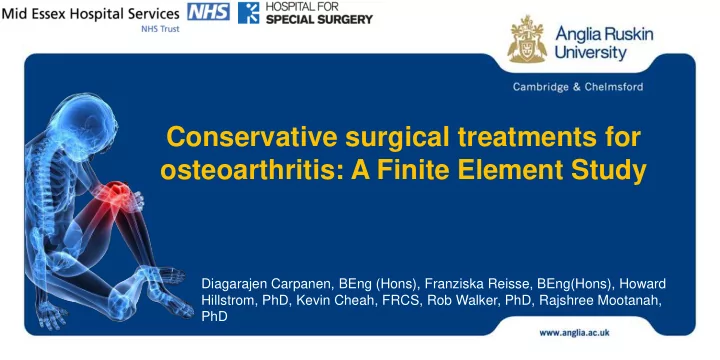

Conservative surgical treatments for osteoarthritis: A Finite Element Study Diagarajen Carpanen, BEng (Hons), Franziska Reisse, BEng(Hons), Howard Hillstrom, PhD, Kevin Cheah, FRCS, Rob Walker, PhD, Rajshree Mootanah, PhD
Introduction • Osteoarthritis (OA) : degenerative disease of all the tissues in the di-arthrodial joint leading to pain, limited mobility and joint deformation. (Coggon, et al., 2000) • 14.1% of men & 22.8% of women over 45 years show symptoms of OA of the knee. (Valkenburg, 1980) • OA costs £12 billion to the NHS and $185.5 billion to the United States annually. (Mathers, at al., 2006)
(Source: Arthritis Research, UK)
Common Causes of Knee Osteoarthritis • Knee malalignment – 4x more prone to develop OA. (Sharma, L., 2001) • Joint injury - a torn meniscus or ligament which can result from a twisting injury ( football, skiing ). (Englund, et al., 2003)
Knee Mal-alignment 5 degrees of varus mal-alignment => 70% - 90% increase in compressive loading in knee joint =>resulting in OA
Meniscus & Meniscal Tears Functions : Load bearing and stabilisation Four Basic Tears : I - longitudinal; II - horizontal; III - oblique; IV - radial (Source: Operative Orthopaedics, 2007)
High Tibial Osteotomy & Partial Meniscectomy • High tibial osteotomy (HTO) is a surgery aiming to relieve pain and restore high-level function in active patients by re-aligning the lower limb and lowering the contact stress in the knee joint. • Partial meniscectomy is an arthroscopic surgical procedure commonly performed to resect the injured part of the meniscus, to relieve symptoms and restore knee function.
Gap in Knowledge • The underlying link between malalignment and stress in the knee compartment is not well understood. Also surgical realignment outcomes by HTO have been unpredictable for unknown reasons • Effects of resecting specific sizes and locations of meniscus on knee joint contact stresses is not clear.
Methodology 3- MATICS Remesh Module Smooth surfaces, Non-Manifold assembly, meshing MIMICS Modules FEA Package Image CT scan /MRI processing, Conversion of generation of 3D mesh to solid structure part & FEA
CT Scan of the Knee • Cadaveric knee joint was CT-scanned, using a GE Medical Systems CT-scanner. • Slice thickness: 0.49mm • Pixel size: 0.6 mm GE's Light Speed Plus Scanner (Courtesy of GE Medical Systems)
MRI of the Knee • MRI data acquired using 3T scanning systems. • A combined 3D spoiled gradient recalled echo (SPGR) and XETA sequence were used to create accurate 3D models of the cartilage and meniscus, respectively. (Mootanah et al., 2011) • In-plane resolution: 0.29 mm x 0.29 mm. GE Healthcare's Signa Excite HD 3T system
3D Knee Model Development Bones Soft Tissues Femoral Cartilage Femur Meniscus MRI scan CT Image Tibial Cartilage Tibia Fibula
Image Registration of Osseous & Soft Tissues • 3D MRI model was registered to the 3D CT model. • Point and global registration techniques were employed, using the minimum RMS error.
Non-manifold Assembly (NMA) • NMA algorithm permits elimination of sections between surfaces. • This ensures that a common border is calculated. • Finally a volume mesh for NMA was created.
Preliminary FEA Studies • Healthy knee Young’s Poisson’s Ratio Material Properties Modulus employed • Knee with a total [MPa] Bones meniscectomy 1000 0.3 Cartilage 50 0.45 • Knee with malalignment Meniscus 112 0.45 Ligaments 400 0.45 Source: Kubicek, M. and Florian,Z., 2009
Contact Definitions Labelling Contact Pair 1 Tibial Cartilage - Meniscus 2 Femoral Cartilage - Meniscus 3 Femoral Cartilage - Tibial Cartilage • Contact Surfaces are allowed to touch but not penetrate.
Boundary Conditions Solve for stress at static equilibrium to simulate standing on one leg: 1. Fix the distal tibia and fibula. 2. Apply axial load at the proximal femur . 3. Set constraints : • Translation free in vertical direction only • Flex/ext constrained to sagittal plane • Other rotational degrees of freedom free
Preliminary Results A Intact knee ~ 2.6 Mpa Total Meniscectomy ~ 4.9 MPa Malaligned Knee ~ 4.2 MPa L M P: posterior A: anterior P M: medial L: lateral
Conclusion Preliminary findings show • the importance of the meniscus in reducing knee joint contact stresses. • that malaligned knees are subjected to high stress levels which indicates the importance of understanding realigning (e.g. HTO) surgical techniques.
Further Works • Simulation of HTOs and partial meniscectomies. • Model cartilages and meniscus as visco-elastic materials. • Model ligaments as hyper-elastic. • Sensitivity analysis.
References Coggon D, Croft P, Kellingray S, Barrett D, McLaren M, Cooper C. Occupational physical activities and osteoarthritis of the knee. ArthritisRheum 2000; 43: 1443-9. Englund, M., Roos, E. and Lohmander, L., 2003. Impact of type of meniscal tear on radiographic and symptomatic knee osteoarthritis: A sixteen ‐ year followup of meniscectomy with matched controls. Arthritis & Rheumatism, 48 (8), pp. 2178-2187. Mathers CD, Loncar D. Projections of global mortality and burden of disease from 2002 to 2030. PLoS Med. 2006; 3:e442. Mootanah, R., Imhauser, C., Koff, M., Potter, H. and Hillstrom, H., 2011. MRI Sequence Influences Geometrical Interpretation of Osseous Tissues, Orthopaedic Research Society 2011. Sharma, L. et al., The role of knee alignment in disease progression and functional decline in knee osteoarthritis. JAMA. 286 (2), 2001 Valkenburg H. Clinical versus radiological osteoarthritis in the general population. In: Peyron J (ed). Epidemiology of Osteoarthritis. Paris: Ciba-Geigy, 1980:53-58.
Acknowledgement • Supervisory Team: Dr Rajshree Mootanah, Dr Rob Walker, Professor Kevin Cheah, Dr Howard Hillstrom • The Higher Education Funding Council for England • The Chelmsford Medical Education and Research Trust
For more information, please visit www.anglia.ac.uk/medeng Or contact: rajshree.mootanah@anglia.ac.uk
Recommend
More recommend